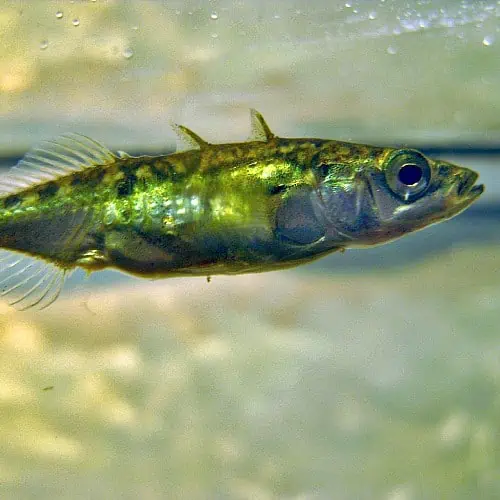
Though koi and goldfish tend to be the most common and understandably popular fish kept in garden ponds, there is an extensive variety of more unusual fish species and specific breeds within each species that are suitable for pond stocking. We like to call them, affectionately, the”oddballs” of the fish and pond keeping hobby!
Whether you can actually have these fish in your pond, of course, depends on your location (the climate, whether or not you live in a watershed area that could impact water quality positively or negatively, specific stocking laws in some cases depending on the country and/or state that you live in, etc.) as well as the size of your pond and what other inhabitant are present.
Why Choose an “Oddball” Pond Fish?
Unusual pond fish have some equally unusual advantages! For example, some fish will eat specific plants which may be a nuisance in your system, or prey on specific insects, pests or larvae which other fish don’t care for. In addition, while koi and goldfish are prevalent and well-liked species, they do have particular habitat requirements that can make them difficult to keep in some cases, whereas some lesser known species may be easier for you to keep (again depending on your location, climate, and so on).
For instance, koi and goldfish don’t tend to tolerate temperatures that fall below 50° Fahrenheit, whereas weather loaches do well in temps as low as 40° F and so could be a better fit for you if you live in a colder region. Others may simply add a distinctive, charming look and flair to your pond – as well as get some strange looks from neighbours and fellow pond keepers!
Below are a variety of unusual pond fish species for freshwater ponds and their habitat requirements to help you determine if any of them may be a good fit for your pond.
Unusual Pond Fish
1) High Fin Banded Shark (Myxocyprinus asiaticus)
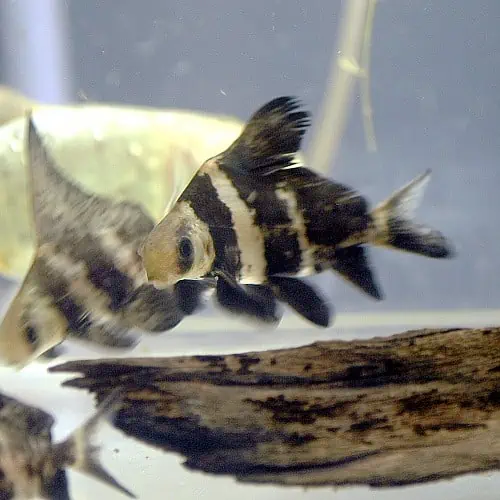
Also known as the batfish due to its dark and somewhat bat-like appearance, the Chinese high fin banded shark is an efficient and attractive algae eater. They can grow up to 4 feet in length, but they’re slow growers and it takes them many years to reach their full adult size. As bottom feeders, they’re a very mellow and peaceful species, getting along well with many other species (though they do prefer to not be the only one of their kind, and are happiest in groups of at least 2 or 3).
A resilient species, the banded shark prefers cooler waters ranging anywhere from 55-75° F (13-24° C) with a pH somewhere between 6.8 and 7.5.
2) Pumpkinseed Fish (Lepomis gibbosus)

Native to North America but an invasive species (and often therefore illegal) in much of Europe, the pumpkinseed fish is in the sunfish family. Like its relatives, the pumpkinseed fish has striking orange-yellow coloring and patterning. They tend to be between 3 and 8 inches in size, and are a very active fish that does best in small schools of 3 or more. Be aware that their energetic, lively nature may stress out more passive fish types, like fancy goldfish. The ideal water parameters for pumpkinseeds are an alkaline pH between 7 and 7.5 and a temperature range of 69 and 75° F (21 to 24° C).
3) Weather Loach (Misgurnus anguillicaudatus)

The weather loach is native to Southeast Asia, but has since been introduced around the world. As their name may imply, weather loaches are rather hardy and do just fine in temperatures that range from 40 to 77° F (4.5-25° C), making them suitable for a large variety of climates and locations (though they do prefer the cooler versus the warmer end of the spectrum). They are moderately social and like to live in small groups, so you’ll need to get more than one, and they eat insects, algae, plant matter, vegetables, and food pellets.
Their maximum size is around a foot in length, and their hardiness combined with not being picky eaters make them a species that works well even for beginning ponders.
4) Silver Bream (Blicca bjoerkna)
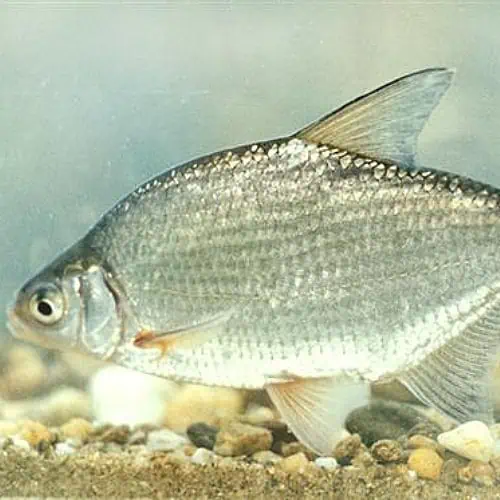
Entirely different from the common bream (which is considered a nuisance species in many areas), the silver bream is an incredibly well-adapted species, more than capable of living in waters that are anywhere from 39 to 72° F (4-22° C). Also called the white bream, silver breams are typically silvery-white with lower underside fins that are always tinged a red-orange color – this color can also spread slightly to the belly in larger, older silver breams. They’re carnivores, and in the wild feed on aquatic invertebrates and insect larvae; this means that they may be useful in helping to control insect populations in your pond if you’re having troubles with that.
They don’t typically grow larger than 14 inches in length, and since they prefer shallower waters (less than a few feet in depth) and are hardy in general, they handle eutrophication well and usually survive it just fine.
5) Gudgeon (Gobio gobio)

Belonging to the Gobi family, gudgeons are found in the wild in most canals in the U.K., but make excellent pond fish due to their small size (usually less than 8 inches in length and half an ounce in weight) as well as their simultaneously peaceful and sociable nature. You’ll need to keep 5 or more to keep them happy, as in the wild they swim about in large shoals. They’re bottom dwellers and feed mostly on insects, larvae, some algae, and insects but you should also provide some supplemental foods, such as pellets, to ensure that they have a well-rounded diet. In the wild, gudgeons play a key role in nutrient cycling and can provide the same benefits in your pond.
They are cold-water fish, and prefer temps that are between 36-64° F (2-18° C) with a pH that is neutral to alkaline (between 7 and 8).
6) Stickleback (Gasterosteidae)

With their interesting dorsal spines, somewhat buggy eyes, and protruding mouth, it’s not overly difficult to see that sticklebacks are more closely related to seahorses and pipefish than to other fish species. They can be found in both marine and freshwater environments, though ocean sticklebacks are covered by protective bony armor plates, whereas freshwater sticklebacks either have none at all or just a handful of them near the head and belly. In fact, freshwater sticklebacks are actively and currently still evolving, with new generations having fewer and fewer armor plates, which enables them to move faster and thus catch the also faster freshwater insects as well as evade predators more easily.
They’re carnivores, but typically only grow less than 6 inches in size so they won’t prey on other fish, but will readily consume insects, crustaceans, and tadpoles (be aware of this if you have or want to have frogs in your pond). Some ponders like them for their bold nature, as they’ll dart about the pond. They seem to do best in temperatures ranging from 50 to 70° F (10-21° C).
7) Sterlet (Acipenser ruthenus)
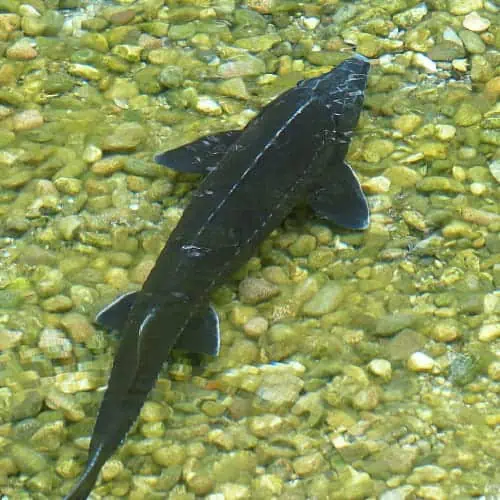
As mentioned in previous articles, though sterlets are the smallest variety of pond sturgeon, they’re still large, growing up to a meter in length, though it does take them about a decade to reach their full size. Nonetheless, these guys are not suitable for small ponds (you’ll need around 2,000 gallons per sterlet), but they’re tolerant of temperatures varying between 50 and 65° F (10-18° C). Sterlets, and pond sturgeons as a whole, are incredibly neat, prehistoric fish whose appearance hasn’t changed much since they evolved around the Triassic Period – they still look like a true living dinosaur, because they essentially are. In fact, they’re among the last remaining remnants of the true bony fishes that used to exist widely in the time of the dinosaurs.
Due to their size, they need to eat a great deal – about 3% of their bodyweight each day, and about 40% of this needs to be protein. While easygoing, slow-moving fish, sterlets have been known to eat smaller guppies and goldfish, so it may not be a good idea to keep these species together.
8) Golden/Common Rudd (Scardinius erythrophthalmus)
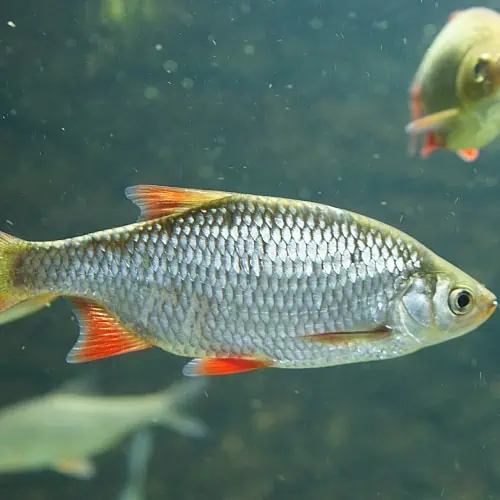
Golden rudds, a variety of common rudd, look somewhat similar to golden orfes, but are smaller with darker orange-gold coloration, often with silvery sides. They may also be entirely silver with bright gold-red tails and fins. They’re also less lively (orfes have a propensity for jumping out of ponds), making them more suitable if you have a smaller pond as they typically only grow to a maximum of 6 inches. They’re native to Britain, and are therefore pretty hardy when it comes to weather and climate, doing well in temperatures ranging from 39 to 72° F (4-22° C) and a pH between 7 and 8.
They prefer to live in small shoals of five or more individuals, and will often group themselves with other shoaling species (such as orfes and gudgeons). They feed on insects, snails, plant detritus, as well as a variety of pellet feeds and dried or frozen fish foods. They need clean water with oxygen levels at or above 7 parts per million.
9) Canary Goldfish (Carassius auratus)

Also known as the canary yellow goldfish for its beautiful golden yellow coloration, these goldies are striking as well as peaceful, pairing well with many other fish, such as other goldies, loaches, guppies, and rudds among others. They have very similar requirements as common goldfish, doing best in temperatures above 65° F and below 72° F (18-22° C). In ponds, they can grow 8 to 12 inches long so long as they have enough space and food.
10) Golden Tench (Tinca tinca)

Domesticated from the common tench that hails from Europe, the golden tench can be pale yellow-gold, deep gold, or even dark red with some individuals having small black spots on their fins and bellies. They’re also known as the doctor fish, due to the (false) belief that their thick slime layer contains antibiotic compounds that help protect surrounding fish from parasites and disease. While they won’t heal other fish, they can still act as a sort of doctor for your pond, as they’re bottom feeders and thus help to cycle nutrients by eating detritus and algae. They like to dig/burrow, particularly during cold weather, so it’s important that you have several inches of sediment at the bottom of your pond, and be aware that this activity may occasionally result in a plant or two being accidentally dug up.
They are also a cold-water fish, doing best in waters that are 39-75° F (4-24° C), and are somewhat tolerant of pH shifts so long as they don’t occur too quickly and pH remains within their 6.5 to 8 range. They’re large, usually growing anywhere from 16 to 26 inches, though smaller as well as larger individuals have been reported; they’ll need a pond that is at least 2.5 feet in depth.


Is it possible to purchase 6 Gudgeon and 6 Golden Rudd from you?